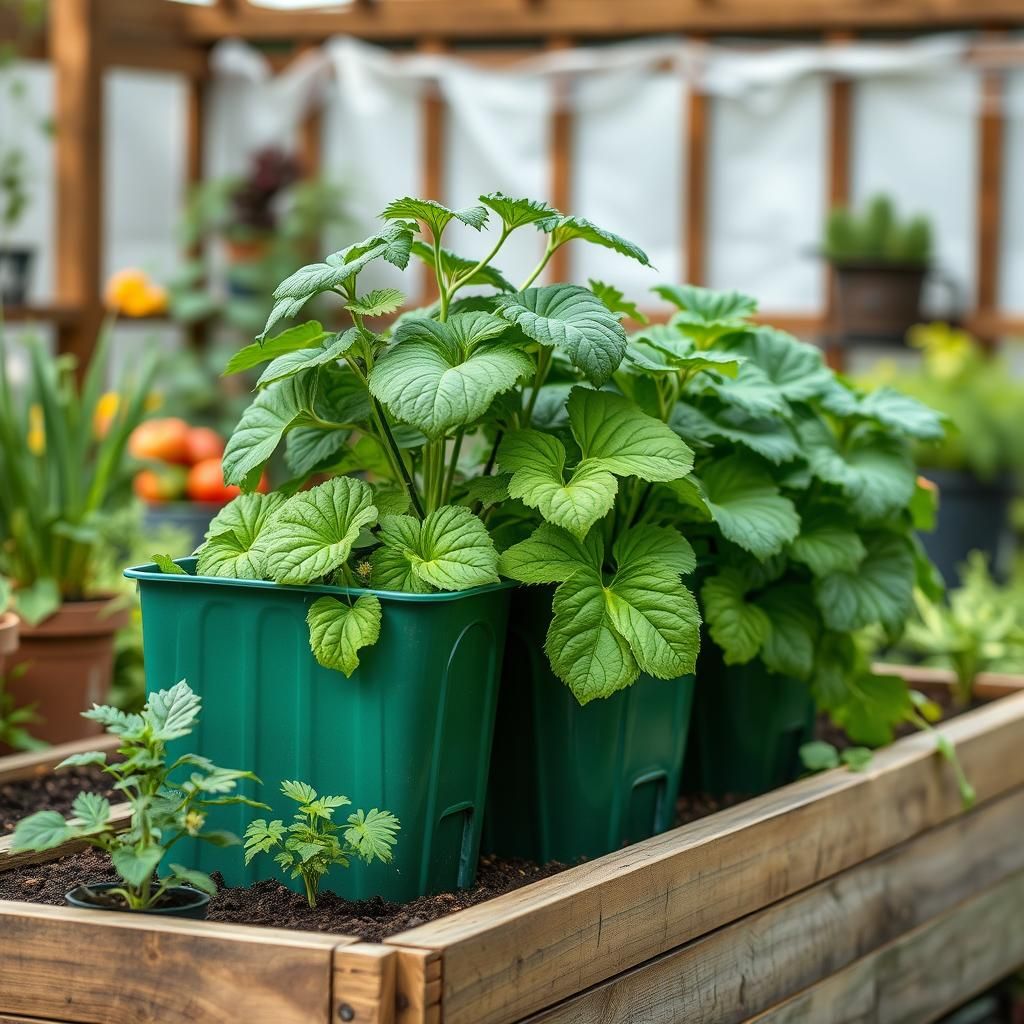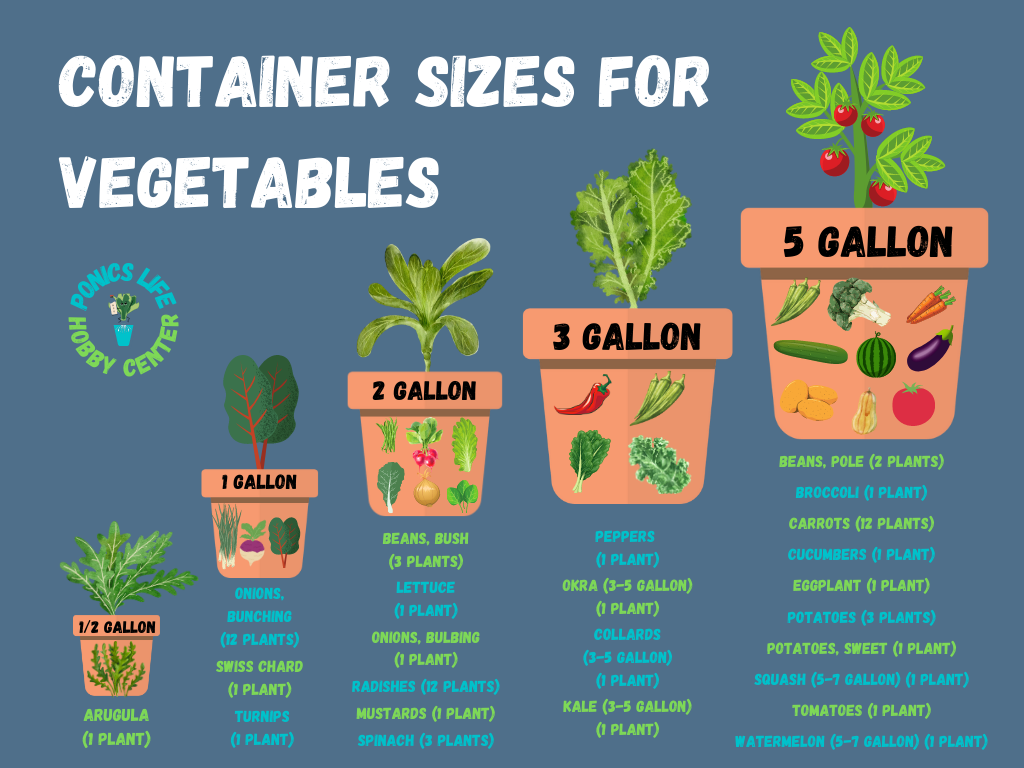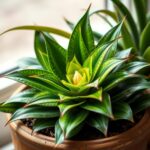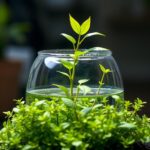Top 10 Container Options for Your Vegetable Garden: Maximize Space and Growth

Creating a thriving vegetable garden requires careful planning, especially when space is limited. Container gardening offers an excellent solution, allowing you to maximize your growing area while providing the ideal environment for your plants. With a wide variety of container options available, the right choice can significantly impact your garden's productivity and aesthetic appeal. In this article, we will explore the top 10 container options for your vegetable garden, highlighting their benefits and suitability for different types of crops. Whether you’re a seasoned gardener or just starting out, these options will help you cultivate a flourishing garden in any space.
Benefits of Container Gardening for Vegetables
Container gardening offers numerous benefits for growing vegetables, particularly for those with limited space or poor soil quality. Utilizing containers allows for greater control over the growing environment, including drainage, soil quality, and plant placement, which can lead to healthier plants and higher yields. This method also provides the flexibility to move the containers for optimal sunlight exposure or to protect the plants from harsh weather conditions. Additionally, container gardening can help deter pests and make it easier to manage weeds. Overall, it is an excellent option for both novice and experienced gardeners looking to cultivate their own nutritious vegetables.
Types of Containers for Vegetable Gardening
There are various types of containers suitable for vegetable gardening, including plastic pots, wooden boxes, ceramic pots, and metal planters. Each type has its own advantages and disadvantages, such as weight, water retention, and aesthetics. Plastic pots are lightweight and affordable, while wooden boxes can provide insulation for the plants' roots. Ceramic pots are visually appealing but may be heavy and breakable, while metal planters often offer modern aesthetics but can overheat in the sun. Choosing the right type depends on the vegetables being grown and the gardener’s preferences.
Soil Requirements for Container Vegetables
The choice of soil is crucial when growing vegetables in containers, as it impacts nutrient availability and drainage. A high-quality potting mix tailored for container gardening is recommended, as it provides the right balance of organic matter, drainage, and moisture retention. Containers do not retain nutrients as well as garden beds, so using a soil mix that includes compost or fertilizers can enhance plant growth. Additionally, regular monitoring of soil moisture levels is essential, as containers can dry out more quickly than garden soil.
Watering Techniques for Container Gardens
Proper watering is vital for the success of container vegetable gardens, as containers can dry out rapidly. It's important to check the moisture level regularly and establish a routine that accommodates the needs of the plants based on factors like temperature, container size, and plant type. Techniques such as drip irrigation or using moisture-retentive materials can help maintain consistent soil moisture. Over-watering should also be avoided, as it can lead to root rot and other diseases. A good rule of thumb is to water deeply but less frequently to encourage strong root systems.
Choosing the Right Vegetables for Containers
Not all vegetables are suitable for container gardening, so selecting the right ones is essential for success. Some of the best choices include salad greens, tomatoes, peppers, and herbs, which typically thrive in confined spaces. It’s also important to consider the mature size of the plants when choosing containers; larger plants like peppers and tomatoes will require bigger pots to accommodate their root systems. Additionally, compact or dwarf varieties of traditional garden plants can also be ideal for container gardening, providing the same delicious harvest in a manageable form.
Placement and Sunlight for Container Gardens
The placement of container gardens is key to ensuring that the vegetables receive the right amount of sunlight. Most vegetables need at least 6-8 hours of direct sunlight per day for optimal growth. Containers can be easily moved to different locations to find areas that receive adequate light. Consider the changing seasons and how sunlight falls throughout the day, as well as the height of surrounding structures or plants that may cast shade. Adequate sunlight exposure is essential for healthy plants and a successful harvest.
| Container Type | Weight | Drainage | Insulation | Aesthetics |
|---|---|---|---|---|
| Plastic Pots | Lightweight | Good | Poor | Varied |
| Wooden Boxes | Moderate | Good | Good | Natural |
| Ceramic Pots | Heavy | Fair | Poor | Elegant |
| Metal Planters | Moderate | Good | Poor | Modern |
What is the best container for a vegetable garden?
:max_bytes(150000):strip_icc()/great-containers-for-growing-vegetables-847834-02-e25bca25ba474ec6971247a2201b9c2d.jpg)
The best container for a vegetable garden largely depends on several factors, including the type of vegetables you plan to grow, available space, and personal preferences. Here are some key characteristics and considerations when selecting the right container:
1. Material: Containers can be made from various materials, including plastic, wood, metal, and ceramic. Each material has its own set of advantages and disadvantages. For example, wooden containers are aesthetically pleasing but may rot over time, while plastic is lightweight and resistant to weathering but may not provide the best insulation for roots.
2. Size: The size of the container is essential for the health of your vegetables. Different plants have different root systems that require varying amounts of space. A general rule of thumb is that larger containers offer more soil volume, which allows for better moisture retention and root growth.
3. Drainage: Proper drainage is crucial to prevent overwatering and root rot. Containers need drainage holes at the bottom to allow excess water to escape. Consider using potting soil that promotes drainage, and don't hesitate to add materials like gravel or perlite to improve soil aeration.
4. Weight: If you plan to move your containers around, consider their weight when filled with soil. Lighter materials, like plastic, may be more practical for mobility, while heavier options may remain stable during wind or rain but can be cumbersome to relocate.
5. Aesthetic Appeal: The appearance of your containers can enhance your garden's overall look. Many gardeners prefer to use attractive pots and planters that suit their outdoor or balcony decor. While functionality is the main goal, visual appeal can add to the enjoyment of gardening.
1. Types of Materials for Garden Containers
Different materials can affect the growth of your vegetables. Here are some common types of materials:
See also:
- Plastic: Lightweight and affordable, but may not hold heat as well.
- Wood: Offers good insulation, but requires maintenance to prevent decay.
- Ceramic: Attractive, but heavy and sometimes fragile.
- Metal: Durable and stylish, though it can heat up quickly in the sun, potentially harming roots.
- Fabric: Breathable and promotes healthy root growth but may dry out faster.
2. Importance of Container Size
The size of your container plays a vital role in the growth of your plants. Consider the following points:
- Root Space: Deeper containers allow for larger root systems, which is essential for healthy growth.
- Soil Volume: More soil means better moisture retention and nutrient availability for plants.
- Types of Vegetables: Some vegetables, like tomatoes, require larger containers, while herbs may thrive in smaller ones.
- Mobility: Larger containers may be harder to move, so consider your garden’s layout.
- Weight & Balance: Ensure that the size of the container is manageable and will not tip over easily.
3. Ensuring Proper Drainage
Effective drainage is essential for the health of your vegetables. Think about these aspects:
- Drainage Holes: Always ensure that your containers have adequate drainage holes at the bottom.
- Soil Mix: Use a suitable potting mix that promotes water drainage.
- Location: Place containers where excess water can drain away easily after rainfall.
- Elevation: Consider elevating containers on pot feet or tiles to enhance drainage.
- Monitoring Moisture: Regularly check soil moisture levels to avoid overwatering.
4. Weight Considerations for Movable Containers
If you'll need to move your containers, consider their weight:
- Lightweight Options: Choose materials like plastic or fabric for easy movement.
- Full Weight: Remember that once filled with soil and water, containers become considerably heavier.
- Placement: Plan where you want to keep containers before filling them.
- Mobility Aids: Consider using plant dolly carts to make relocation easier.
- Permanent vs. Temporary: Decide if the containers will have a permanent position or if you need flexibility.
5. Aesthetic Appeal and Design
Containers can greatly enhance the look of your garden space. Keep in mind:
- Style Choices: Choose containers that match your personal style or the theme of your garden.
- Color and Texture: Use a variety of colors and finishes to create visual interest.
- Groupings: Plant multiple containers together to create stunning focal points.
- Plant Variations: Mix different plants and flowers in the same container for a colorful display.
- Seasonal Changes: Think about how your container's aesthetics will change with the seasons.
Are 5 gallon buckets good for growing vegetables?
Using 5-gallon buckets for growing vegetables can be an excellent choice for many gardeners, particularly those with limited space and resources. These buckets are versatile and can provide a controlled environment for plants. Below are some detailed considerations regarding their use in vegetable gardening.
Advantages of Using 5-Gallon Buckets
5-gallon buckets offer several advantages for growing vegetables, primarily due to their size and accessibility. Here are some key points:
- Mobility: They can be easily moved around your garden or patio, allowing for optimal sunlight exposure.
- Drainage: Buckets can be drilled for proper drainage, preventing root rot and ensuring that plants receive just the right amount of water.
- Soil Management: You can choose the soil mix that best suits your plants, leading to healthier growth.
Best Vegetables for 5-Gallon Buckets
Not every vegetable thrives in a bucket, but many do. Choosing the right plants will help ensure success. Here are some excellent options:
- Tomatoes: They thrive in the warmth and have enough space for their roots.
- Peppers: Compact varieties grow well in the limited space of a bucket.
- Lettuce: Fast-growing and shallow-rooted, lettuce is perfect for container gardening.
How to Prepare 5-Gallon Buckets for Planting
Preparing the buckets properly is crucial for healthy vegetable growth. Here’s how to get started:
- Clean the Buckets: Ensure the buckets are free from chemicals or residues that could harm plants.
- Drill Drainage Holes: Create several small holes at the bottom to allow excess water to escape.
- Add Soil Mixture: Use a well-draining potting mix that provides essential nutrients for your vegetables.
Watering and Maintenance Requirements
Like any container garden, 5-gallon buckets need specific attention regarding watering and maintenance. Here’s what to consider:
- Regular Watering: Buckets can dry out quickly, so check moisture levels consistently.
- Fertilization: Use slow-release fertilizers to ensure a steady supply of nutrients as plants grow.
- Sunlight Exposure: Position buckets where they can receive sufficient sunlight—most vegetables require at least 6 hours of sun daily.
Potential Challenges with 5-Gallon Buckets
While they are beneficial, there are also some challenges to consider when using buckets for vegetable gardening:
- Heat Retention: Buckets can heat up quickly in direct sunlight, potentially stressing the plants.
- Limited Space: Only certain vegetables can thrive in the limited soil volume, which may restrict plant choices.
- Pest Management: Containers can attract pests, requiring vigilant monitoring and management strategies.
How deep do containers need to be for vegetables?

To successfully grow vegetables in containers, depth is a crucial factor that varies depending on the type of vegetable being cultivated. Generally, the minimum depth for containers should range from 6 to 12 inches (15 to 30 cm), but some deeper-rooted vegetables will require more space. Here’s a detailed explanation of what you need to consider for container depth based on the type of vegetables you are planning to grow.
Depth Requirements for Root Vegetables
Root vegetables like carrots, beets, and radishes require deeper containers to allow for the growth of their roots. A depth of at least 12 to 18 inches (30 to 46 cm) is recommended to accommodate the root system properly. This depth ensures adequate space for the roots to expand, leading to healthier and larger yields.
- Carrots: Ideally need a minimum of 12 inches of depth.
- Beets: Require about 12 to 15 inches for optimal growth.
- Radishes: Can thrive in containers of 6 to 12 inches but do best in deeper containers.
Shallow-Rooted Vegetables
Vegetables with shallow root systems, such as lettuce, spinach, and herbs, can be grown in containers that are only 6 to 8 inches deep. This is sufficient for their roots to spread without requiring excessive soil volume.
See also:
- Lettuce: Grows well in containers of 6 to 8 inches.
- Spinach: Performs optimally in containers that are also around 6 to 8 inches deep.
- Herbs: Most culinary herbs do not need more than 6 to 8 inches of depth.
Climbing Plants and Tomatoes
For climbing plants such as tomatoes, peas, and cucumbers, the recommended container depth is usually 12 to 18 inches (30 to 46 cm). This depth allows space for the root structure and provides stability for support structures like stakes or cages.
- Tomatoes: Best grown in containers of at least 12 to 18 inches deep, especially indeterminate varieties.
- Peas: Require a minimum of 12 inches for healthy root development.
- Cucumbers: Thrive in containers that are 12 inches deep for better root support.
Container Soil Volume and Quality
While container depth is important, the soil volume also plays a vital role in the health of the plants. A deeper container can hold more soil, which helps retain moisture and nutrients for the plants. Quality soil mix should also be considered to promote healthy plant growth.
- Soil Mix: A good-quality potting mix with organic matter is recommended.
- Moisture Retention: Deeper containers can retain moisture better, reducing the need for frequent watering.
- Nutrient Availability: Ensuring a sufficient volume of soil can improve nutrient availability for the plants.
Container Material and Insulation
The choice of container material can also affect the temperature and moisture levels within the soil. Containers made of different materials may insulate differently, impacting root growth.
- Plastic Containers: Good for insulation and retaining moisture, often lightweight.
- Clay Pots: These allow for good air circulation but can dry out quicker.
- Wooden Boxes: Suitable for deeper planting, but should be lined to prevent soil loss.
How many vegetables can I grow in a 5 gallon container?
To determine how many vegetables you can grow in a 5-gallon container, it generally depends on the type of vegetable and how much space each plant requires to thrive. A 5-gallon container can accommodate a variety of vegetables, but here are some guidelines to consider:
1. Leafy Greens: You can grow several leafy greens in a 5-gallon container.
2. Root Vegetables: These usually require more space due to their growth habits.
3. Compact Varieties: Dwarf or compact vegetable varieties are well-suited for container gardening.
4. Spacing: Proper spacing between plants is crucial to prevent overcrowding and ensure healthy growth.
On average, you could grow about 3-5 plants of certain types or 1-2 larger plants like tomatoes or peppers in a 5-gallon container. Below are related subtopics that can provide a deeper understanding.
Choosing the Right Vegetables for Container Gardening
Growing vegetables in a 5-gallon container requires choosing varieties that are suitable for limited space. Here are some recommended options:
- Leafy Greens: Spinach, lettuce, and kale thrive in containers.
- Herbs: Basil, parsley, and cilantro can grow well alongside other plants.
- Compact Varieties: Look for smaller versions of peppers, tomatoes, and cucumbers.
Considerations for Plant Spacing
Proper spacing is critical in container gardening. In a 5-gallon container, follow these guidelines:
- Leafy Greens: Space them about 4-6 inches apart.
- Tomatoes: Plant only one mature tomato plant per container.
- Root Vegetables: Beets and carrots can be spaced 2-3 inches apart.
Soil Requirements for Container Vegetables
The type of soil you use can significantly impact plant growth. Here are some tips:
- Quality Soil Mix: Use a high-quality potting mix designed for container gardening.
- Drainage: Ensure proper drainage by adding perlite or vermiculite.
- Fertilization: Regularly add slow-release fertilizers to nourish your plants.
Watering Needs for Container Vegetables
Watering is essential for container plants, especially in a 5-gallon container. Here are some considerations:
- Consistent Moisture: Keep the soil consistently moist but not soggy.
- Check Daily: During hot weather, check soil moisture levels daily.
- Drainage Holes: Ensure containers have good drainage holes to prevent water logging.
Harvesting and Maintenance Tips
To maximize your yield from a 5-gallon container, consider these maintenance strategies:
- Regular Pruning: Trim back excess foliage to encourage healthy growth.
- Consistent Harvesting: Regularly harvest mature vegetables to promote further production.
- Watch for Pests: Keep an eye out for common pests and treat them promptly.
Questions from Our Readers
What is a container for vegetable gardening?
A container for vegetable gardening is a specially designed vessel used to grow plants in a limited space, often allowing for better drainage and mobility. These containers can be made from various materials such as plastic, metal, or ceramic, and are suitable for various types of vegetables and herbs.
What are the benefits of using containers for vegetables?
Using containers for growing vegetables offers numerous advantages, including the ability to control soil quality, improve drainage, and protect plants from pests. Containers also allow for versatility in placement, making it easier to take advantage of sunlight and space.
Can any vegetable be grown in containers?
Most vegetables can be grown in containers, but it's essential to choose those that are suitable for limited space. Lettuce, herbs, and radishes are great for small containers, while larger vegetables like tomatoes and peppers require bigger pots for proper root development.
See also:
How do I care for a vegetable container garden?
Caring for a vegetable container garden involves regular watering, ensuring adequate sunlight, and providing nutrients through fertilizers. Additionally, keep an eye on pests and diseases, and promptly address any issues to ensure healthy plant growth.

If you want to read more articles like Top 10 Container Options for Your Vegetable Garden: Maximize Space and Growth, we recommend you check out our Planter category.
Leave a Reply


Related Articles